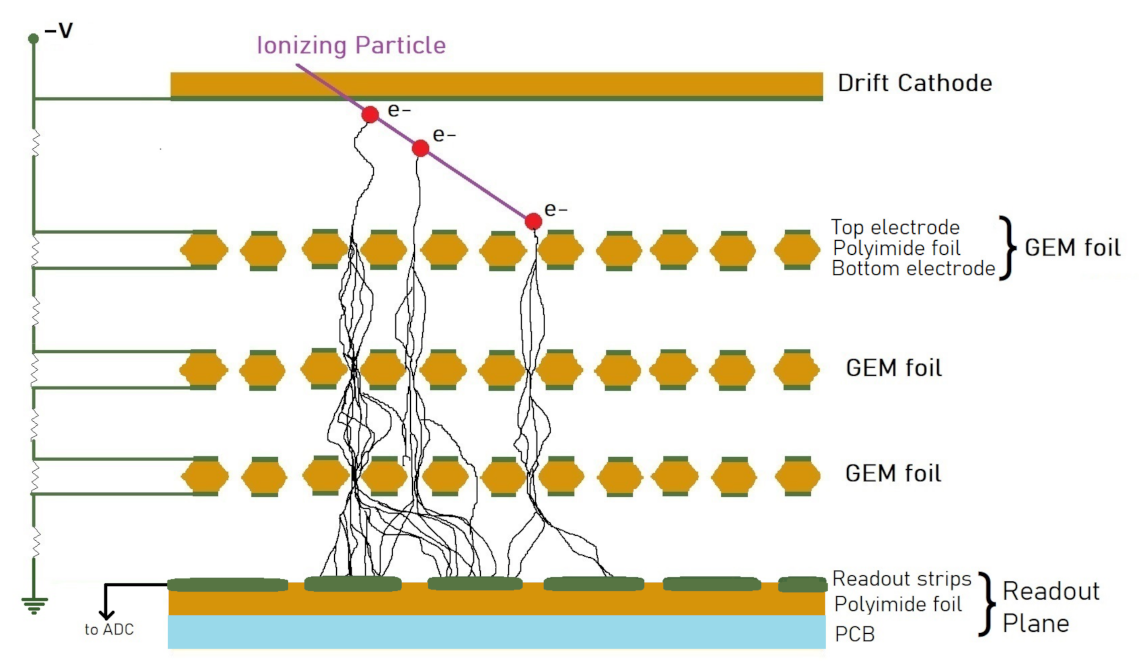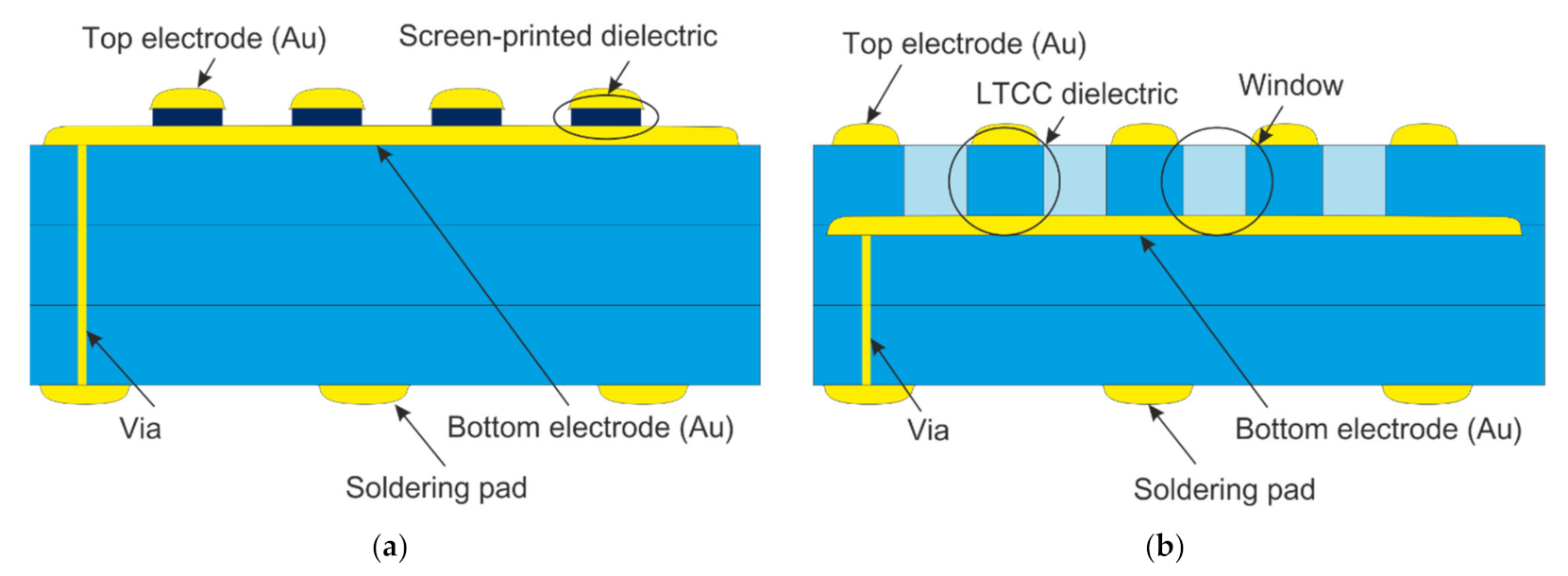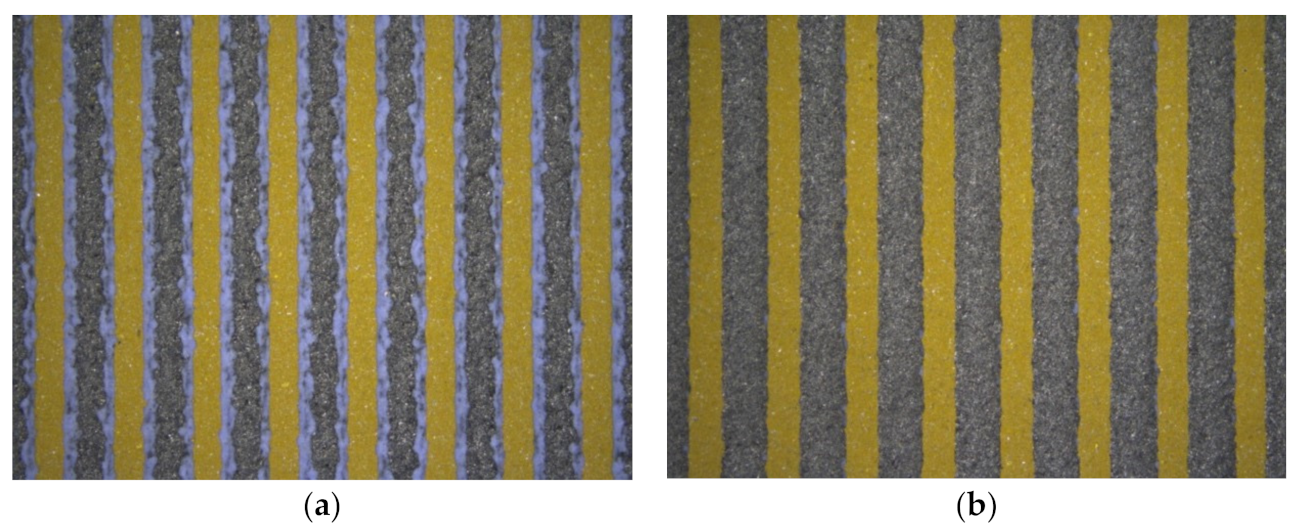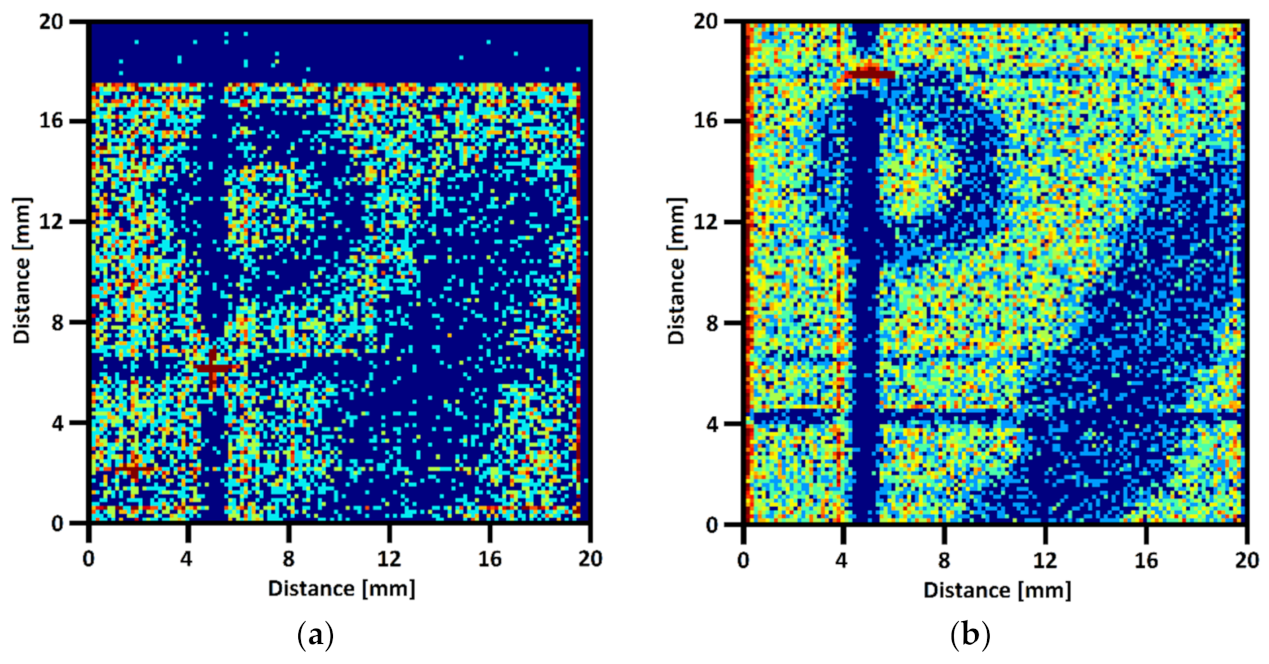LTCC Strip Electrode Arrays for Gas Electron Multiplier Detectors
Abstract
1. Introduction
2. Materials and Methods
2.1. Single Substrate (SS) Approach
2.2. Multi Substrate (MS) Approach
2.3. Sintering and Assembly
2.4. The GEM Detector Assembly
3. Results
3.1. Visual Inspection
3.2. Analysis of LTCC Readout Boards Done with the Electrical and X-ray Methods
4. Discussion
Author Contributions
Funding
Conflicts of Interest
References
- Charpak, G.; Bouclier, R.; Bressani, T.; Favier, J.; Zupančič, Č. The use of multiwire proportional counters to select and localize charged particles. Nucl. Instrum. Methods 1968, 62, 262–268. [Google Scholar] [CrossRef]
- Lindström, G.; Ahmed, M.; Albergo, S.; Allport, P.; Anderson, D.; Andricek, L.; Angarano, M.M.; Augelli, V.; Bacchetta, N.; Bartalini, P.; et al. Developments for radiation hard silicon detectors by defect engineering—Results by the CERN RD48 (ROSE) Collaboration. Nucl. Instrum. Methods Phys. Res. Sect. A Accel. Spectrom. Detect. Assoc. Equip. 2001, 465, 60–69. [Google Scholar] [CrossRef]
- Titov, M.; Ropelewski, L. Micro-Pattern Gaseous Detector Technologies And RD51 Collaboration. Mod. Phys. Lett. A 2013, 28, 1340022. [Google Scholar] [CrossRef]
- Shekhtman, L. Micro-pattern gaseous detectors. Nucl. Instrum. Methods Phys. Res. Sect. A Accel. Spectrom. Detect. Assoc. Equip. 2002, 494, 128–141. [Google Scholar] [CrossRef]
- Bressan, A.; De Oliveira, R.; Gandi, A.; Labbé, J.-C.; Ropelewski, L.; Sauli, F.; Mörmann, D.; Müller, T.; Simonis, H.J. Two-dimensional readout of GEM detectors. Nucl. Instrum. Methods Phys. Res. Sect. A Accel. Spectrom. Detect. Assoc. Equip. 1999, 425, 254–261. [Google Scholar] [CrossRef]
- Hill, J.E.; Black, J.K.; Brieda, L.; Dickens, P.L.; de Garcia, K.M.; Hawk, D.L.; Hayato, A.; Jahoda, K.; Mohammed, J. Lifetime estimation of a time projection chamber X-ray polarimeter. In Proceedings of the UV, X-ray, and Gamma-Ray Space Instrumentation for Astronomy XVIII, San Diego, CA, USA, 25–29 August 2013; Volume 8859. [Google Scholar]
- Jurków, D.; Maeder, T.; Dąbrowski, A.; Zarnik, M.S.; Belavič, D.; Bartsch, H.; Müller, J. Overview on low temperature co-fired ceramic sensors. Sens. Actuators A Phys. 2015, 233, 125–146. [Google Scholar] [CrossRef]
- Dąbrowski, A.P.; Golonka, L.J. High Pressure Sensor with PZT Transducer in LTCC Package. Procedia Eng. 2014, 87, 1099–1102. [Google Scholar] [CrossRef][Green Version]
- Dąbrowski, A.; Elkjaer, K.; Borregaard, L.; Zawada, T.; Golonka, L. LTCC/PZT accelerometer in SMD package. Microelectron. Int. 2014, 31, 186–192. [Google Scholar] [CrossRef]
- Testa, D.; Corne, A.; Jacq, C.; Maeder, T.; Toussaint, M.; Antonioni, S.; Chavan, R.; Couturier, S.; Dolizy, F.; Lavanchy, P.; et al. LTCC magnetic sensors at EPFL and TCV: Lessons learnt for ITER. Fusion Eng. Des. 2019, 146, 1553–1558. [Google Scholar] [CrossRef]
- Nawrot, W.; Drzozga, K.; Baluta, S.; Cabaj, J.; Malecha, K. A Fluorescent Biosensors for Detection Vital Body Fluids’ Agents. Sensors 2018, 18, 2357. [Google Scholar] [CrossRef] [PubMed]
- Słobodzian, P.; Szostak, K.; Skowronek, K.; Jasińska, L.; Malecha, K. An Ultrahigh Sensitive Microwave Microfluidic System for Fast and Continuous Measurements of Liquid Solution Concentrations. Sensors 2021, 21, 5816. [Google Scholar] [CrossRef] [PubMed]
- Wolff, I.; Günner, C.; Kassner, J.; Kulke, R.; Uhlig, P. New Heights for Satellites: LTCC Multilayer Technology for Future Satellites. IEEE Microw. Mag. 2018, 19, 36–47. [Google Scholar] [CrossRef]
- Wolff, I.; Kulke, R.; Klein, T. LTCC: A Space Qualified Integration and Packing Technology for Millimeter-Wave Systems WFA: Integration and Technologies for mm-Wave Sub-Systems. In Proceedings of the Workshop Presentation of the 2012 IEEE/MTT-S International Microwave Symposium Digest, Montreal, QC, Canada, 17–22 June 2012. [Google Scholar]
- Komiya, K.; Takeuchi, Y.; Wakabayashi, M.; Fujiwara, K.; Kono, S.; Hamagaki, H.; Tamagawa, T. Development of Gas Electron Multiplier by Applying Technique of Low Temperature Co-Fired Ceramics. J. Jpn. Soc. Precis. Eng. 2018, 84, 936–940. [Google Scholar] [CrossRef][Green Version]
- Cappuzzello, F.; Acosta, L.; Agodi, C.; Boztosun, I.; Brischetto, G.A.; Calabrese, S.; Calabretta, L.; Calvo, D.; Campajola, L.; Capirossi, V.; et al. The NUMEN Project: An Update of the Facility Toward the Future Experimental Campaigns. Front. Astron. Space Sci. 2021, 8, 52. [Google Scholar] [CrossRef]
- Finocchiaro, P.; Acosta, L.; Agodi, C.; Altana, C.; Amador-Valenzuela, P.; Boztosun, I.; Brasolin, S.; Brischetto, G.A.; Brunasso, O.; Calabrese, S.; et al. The NUMEN Heavy Ion Multidetector for a Complementary Approach to the Neutrinoless Double Beta Decay. Universe 2020, 6, 129. [Google Scholar] [CrossRef]
- Standard GEM Assembly V2. Available online: https://franchin.web.cern.ch/franchin/MPDG/GEM_assembly_DRAFT.pdf (accessed on 12 December 2021).
- Franchino, S. GEM and Micromegas standard detectors. In Proceedings of the International Workshop on Advanced Detectors (IWAD) and RD51 Collaboration Meeting, Kolkata, India, 29–31 October 2014. [Google Scholar]
- GEM-Based Detector. Available online: https://techtra.pl/en/technology/gem-based-detector/ (accessed on 12 December 2021).












| Board | Nr of Shorts | X Coordinates | Y Coordinates |
|---|---|---|---|
| SS-DG | 27 (2 blocks) | 23, 29, 47–49, 51, 53, 55, 58 60, 61, 63, 65–69 | 2, 4–10, 20, 24 |
| SS-GD | 2 | 36 | 47 |
| 59 | 32 | ||
| MS | 1 | 22 | 58 |
| Board | Channels | Avg. Noise [fC] | Max Noise [fC] | RMS Noise [fCRMS] |
|---|---|---|---|---|
| MS | X (TOP) | 7.87 | 17.85 | 2.26 |
| Y (BOT) | 10.69 | 26.71 | 4.58 | |
| SS-GD | X (TOP) | 7.77 | 18.25 | 2.86 |
| Y (BOT) | 9.81 | 29.98 | 3.86 |
| Board | Channels | Gauss Center [pC] | Total Charge [%] |
|---|---|---|---|
| MS | X (TOP) | 4.11 | 89.4 |
| Y (BOT) | 0.49 | 10.6 |
Publisher’s Note: MDPI stays neutral with regard to jurisdictional claims in published maps and institutional affiliations. |
© 2022 by the authors. Licensee MDPI, Basel, Switzerland. This article is an open access article distributed under the terms and conditions of the Creative Commons Attribution (CC BY) license (https://creativecommons.org/licenses/by/4.0/).
Share and Cite
Dąbrowski, A.; Nawrot, W.; Czok, M.; Babij, M.; Bielówka, P.; Malecha, K. LTCC Strip Electrode Arrays for Gas Electron Multiplier Detectors. Sensors 2022, 22, 623. https://doi.org/10.3390/s22020623
Dąbrowski A, Nawrot W, Czok M, Babij M, Bielówka P, Malecha K. LTCC Strip Electrode Arrays for Gas Electron Multiplier Detectors. Sensors. 2022; 22(2):623. https://doi.org/10.3390/s22020623
Chicago/Turabian StyleDąbrowski, Arkadiusz, Witold Nawrot, Mateusz Czok, Michał Babij, Piotr Bielówka, and Karol Malecha. 2022. "LTCC Strip Electrode Arrays for Gas Electron Multiplier Detectors" Sensors 22, no. 2: 623. https://doi.org/10.3390/s22020623
APA StyleDąbrowski, A., Nawrot, W., Czok, M., Babij, M., Bielówka, P., & Malecha, K. (2022). LTCC Strip Electrode Arrays for Gas Electron Multiplier Detectors. Sensors, 22(2), 623. https://doi.org/10.3390/s22020623






